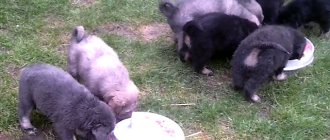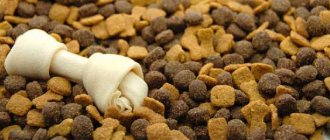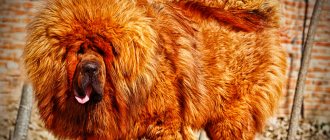4.3 / 5 ( 3 voices)
Good conditions for keeping a Tibetan mastiff can be created in a private or country house with a spacious plot and a strong fence. Don’t think that mastiffs are prone to running away from home, they just have highly developed protective instincts, and their spectacular appearance and powerful roar will scare anyone. Ancient chronicles indicate that to protect an entire village or monastery in ancient Tibet, only one Tibetan mastiff was considered sufficient. Therefore, in order to avoid problems with random passers-by, the fence should be made higher and stronger.
It is best to keep a Tibetan mastiff in a private house, not in an apartment.
Daily norm
Such a large dog needs high-quality nutrition, enriched with a sufficient amount of vitamins and minerals. When kept in an enclosure, Tibetan mastiffs need good food in order to withstand any weather conditions.
How many times a day to feed your dog depends on its age. Mastiff puppies are fed frequently, at least 4 times a day. After a year, dogs are switched to two meals a day.
The amount of food consumed depends on the size of the dog, but should be at least 3% of the total weight. For example, with a weight of 70 kg, the daily amount of food should be 2.1 kg. Considering two meals a day, we get about a kilogram portion of food.
It is worth noting that when feeding a dog with ready-made food, the portion may be smaller. Super premium food is already balanced and concentrated. The table on the packaging will help you calculate a single serving; it is present on any pack.
IMPORTANT!
You cannot overfeed your dog. Obesity may develop, which in turn can cause joint problems or heart disease.
We teach correctly
The Tibetan Mastiff is an independent and stubborn dog. Therefore, care alone will not be enough for her. From the first days a puppy appears in your home, you need to start raising and training it. Communication with your pet should be friendly, strict, without unnecessary emotions or aggression on your part.
Dogs of this breed are not particularly energetic and tend to make their own decisions. You will have to make every effort to make your pet respect and obey you. Therefore, training a Tibetan mastiff should begin with a general obedience course so that the animal can immediately adapt to new conditions.
Teaching a dog good behavior and manners includes teaching it a name, a toilet, a place, a feeding and walking schedule, and grooming procedures. Raising a pet must be combined with the basics of training, reinforcing each skill with the appropriate commands: “Come”, “Toilet”, “Place”, “Eat”, “Stand”, “Sit”, “Walk”.
Be sure to teach your puppy no commands. Use the "Fu" order if you want to stop the dog's action at the moment. The “No” order should stop any actions of your pet that are objectionable to you once and for all.
Remember, the Tibetan Mastiff, due to its stubborn nature, may not immediately begin to carry out your instructions. But if you can get him to learn a certain skill, then he will stay with the dog for a long time. However, do not forget to repeat the material covered from time to time, otherwise your pet may decide that the previous lessons no longer need to be completed.
Additionally, the dog will need to take a UGS (controlled city dog) course. Also, it would not be amiss for the Tibetan Mastiff to additionally take a course in training in the skills of protective guard service.
Tell us, how do you keep, feed, raise and train your dog?
Dry food or natural food?
Breeders still have not come to a clear opinion on what is the best way to feed Tibetans. The only thing both sides agree on is that dogs cannot be fed a mixed diet . This may cause an excess of minerals or vitamins in the body, which will negatively affect the dog’s health.
Each option has its own advantages. When eating natural foods, you can be sure that what the dog eats, that it will not receive junk food or anything spoiled. In addition, feeding natural products is cheaper.
The advantages of ready-made feed are as follows:
- saving time on cooking
- a balanced complex of vitamins and minerals already included
- more convenient to feed
- Huge range for every breed and age
- confidence in the quality of the product
As a result, only its owner chooses what to feed the dog. The main thing is that in both cases the quality of the products does not suffer, otherwise the animal will suffer.
NOTE!
According to the veterinarian, it is better to feed the dog natural food. It has a more favorable effect on the functioning of the animal’s body, but it is necessary to add vitamins to the diet. If you still decide to feed dry food, then you need to choose a premium class, which definitely does not contain unnecessary additives. It will cost more, but the dog's health is worth it.
Description of the breed
What does a Tibetan Mastiff look like?
Representatives of the breed are significantly larger in size than humans. In the area of the sternum, the fur is thickest, so it looks like a lion's mane. Thanks to this, the dog looks even more voluminous.
In addition to the external component, such wool well protects the animal from bites of wild animals.
Physical characteristics, according to FCI standard:
- The growth of the dog along with the withers affects the body weight. The larger it is, the more unique the individual becomes.
- The head is large in size with a massive and fairly wide skull. The transition from the forehead to the large muzzle is clearly defined. The nose is black, with large, wide-open nostrils.
- Well developed jaw muscles, with a scissor or level bite. The teeth are strong and white.
- The eyes are almond-shaped, the iris has a dark tint.
- The triangular ears are set high on the head and hang down along the muzzle. They are in an elevated state when the dog listens or becomes alert.
- Massive body with a strong skeleton. Deep chest and wide back.
- The medium-length tail widens at the base.
- Strong straight limbs with oval paws.
- The thick and warm fur consists of fine hairs.
Pros and cons of natural food
Pros:
- Independent selection of products and their quality
- No preservatives, emulsifiers or other additives in food
- If you have an allergy, it’s easier to figure out the ingredient and replace it
- The presence of natural minerals in the diet - protein, fiber, carbohydrates and fats
- happy and contented animal
Minuses:
- it is necessary to maintain a strictly balanced diet so that all the necessary minerals are present
- need to add vitamin supplements
- takes a long time to prepare
- With natural feeding, it is difficult to travel with a dog, as it requires a place to prepare food
List of permitted and prohibited products
The following products are allowed for natural nutrition:
- lean meat (veal, beef, lamb)
- poultry (chicken, turkey, quail)
- ocean and sea fish (tilapia, tuna, pollock, white fish)
- milk products (low-fat yoghurts without additives, kefir, fermented baked milk, cottage cheese)
- cereals (rice, buckwheat). You can cook it in water, meat and fish broths. You can make porridge from several grains at once.
- offal (liver, lung, tongue, tripe, chicken offal). The portion is increased by one and a half to two times, since they have a lower energy value than meat.
- eggs. Chicken or quail. Give 1-2 times a week, raw or boiled.
- vegetables, fruits and herbs. It is a must to add to your dog's diet. Fresh, boiled or stewed, grated or pureed. But do not give too sweet and juicy fruits.
- bones. Only strong, non-tubular bones should be allowed to be chewed by the dog. They help remove plaque from teeth.
Prohibited products:
- boiled, tubular and fish bones
- fatty meat (pork, lamb)
- sweets and pasta
- sweets and confectionery
- smoked meats and sausages
- milk
- fresh, frozen meat
- by-products without heat treatment
- raw fish
- potatoes and tomatoes
- spicy and salty foods, marinades
- spoiled and sour products
- sweet and juicy fruits, citrus fruits
- cabbage, spinach, legumes - vegetables that cause fermentation in the intestines and flatulence
CAREFULLY!
Never feed your mastiff food from the master's table! This is not suitable food for your pet and will develop the bad habit of begging in your dog.
We take proper care
Dog grooming
The Tibetan Mastiff has a luxurious coat that requires proper care. Several times a week you need to comb your pet (from the head and further in the direction of hair growth), using tools such as a long-tooth comb and a slicker comb. This will be enough for a puppy.
An adult dog begins to shed. This usually happens in the spring. During this period, you will have to comb out dead hair daily using the same tools. It is best to do this outside so as not to contaminate the floor in the house, because there will be a lot of dead hairs.
The dog may also develop tangles near the ears, in the neck area and on the “pants”. You can get rid of them using a tangle cutter, a detangling spray, a slicker comb, and a long-toothed comb.
To prevent your Tibetan Mastiff from injuring its paws, you need to periodically remove the hair between its toes. Otherwise, small stones, burdocks, and so on may get stuck there. They leave scratches on the skin, which can lead to inflammation.
Dogs of this breed are washed using soap very rarely - a maximum of four times a year. It is not recommended to bathe your pet in winter, as its fur takes a very long time to dry. Due to the cold and drafts, this can lead to the animal catching a cold.
If the Tibetan Mastiff is very dirty, then you can use dry shampoos in the form of powder, spray or powder. After walks, be sure to wipe your pet's paws with a damp cloth.
Caring for a dog also includes:
- timely trimming of nails;
- examining and cleaning ears as needed;
- washing the eyes with chamomile infusion (two to three times a week);
- examination of the oral cavity and daily brushing of teeth.
Remember that you need to accustom a puppy to grooming procedures from an early age so that an adult dog is calm about caring for it.
Diet
Special care for such an impressive dog as the Tibetan Mastiff includes proper diet and nutrition. You can feed your pet two types of food: natural food or prepared food. You cannot mix two types of food. This can lead to an overdose or lack of vitamins and minerals.
The best option for the health of Tibetan Mastiffs is to feed them natural foods. From one month to two months, a puppy must be fed six times a day, evenly distributing the following foods:
- lean meats such as beef or turkey;
- fermented milk products, such as kefir or cottage cheese;
- cereals: rice or buckwheat;
- boiled eggs (no more than two per week);
- boiled vegetables such as carrots, pumpkin or cabbage;
- fresh fruits such as apples;
- vegetable oils: olive, flaxseed or vegetable;
- greenery.
Vitamin and mineral supplements should be added to the food according to the veterinarian’s recommendations.
From two to six months, the puppy should be fed five times a day. Now you can add boiled sea fish to the main products, after removing the bones. After six months, the Tibetan Mastiff can be fed four times a day. You should feed an adult dog two to three times a day, giving him the same foods that you gave the puppy.
The amount of food for the whole day is calculated at three percent of the pet’s weight. If a dog weighs thirty kilograms, then it should eat nine hundred grams of food per day. Naturally, the total volume of food should be evenly divided into equal shares, according to the number of feedings per day.
Sample menu for a week for a mastiff
For each mastiff, the amount of daily food intake is calculated individually, depending on its weight. It must be at least 3% of the total weight of the animal.
The presented menu is designed for a dog weighing 70-80 kg for two meals a day. That is, the total volume of 2100 g is divided into two portions of 1050 g.
| Products | Days of the week | ||||||
| 1st day | 2nd day | 3rd day | 4th day | 5th day | 6th day | 7th day | |
| fish | — | 400 | — | — | — | 400 | — |
| raw meat, offal | 1000 | 600 | 1000 | 1000 | 1000 | 600 | 1000 |
| rice cereal | — | 400 | — | — | — | — | 400 |
| buckwheat | 400 | — | 400 | 400 | 400 | 400 | — |
| dairy products | 100 | 100 | 150 | 100 | 100 | 150 | 100 |
| eggs | 100 | — | — | — | 100 | — | — |
| vegetables and fruits | 400 | 400 | 350 | 400 | 400 | 350 | 400 |
| animal fat | 50 | 50 | 50 | 50 | 50 | 50 | 50 |
| salt | 50 | 50 | 50 | 50 | 50 | 50 | 50 |
Story
The dog was first mentioned back in 1122 BC. e. in the ancient letters of China. It was there that the description of the breed was given special significance. It is believed that the Himalayan mastiff descended from the Central Asian Shepherd Dog. The dog gave impetus to the appearance of mountain shepherd dogs with long hair.
Aristotle accurately described the characteristics of the mastiff, even mentioning the dull bark characteristic of the dog of Tibet. According to the philosopher, the breed is a mixture of a dog and a tiger.
The navigator Marco Polo, seeing the animal while traveling in China (XV century), was amazed by their appearance: a huge animal, like a donkey, with a ferocious character. In the 19th century, several giants were presented to George V. Since then, the dog has been considered the favorite of the entire European elite.
Initially, the breed was planned to be used as assistants for monks in mountain monasteries, but it became a luxury for old China. Only the wealthiest people could own a mastiff. The dogs were distinguished by their terrifying appearance and formidable character. Therefore, when several specimens were brought to London, professional tamers could not cope with them. Then the mastiffs were sent to the zoo.
History says that in the 20th century the breed was in danger of extinction. A crisis came, the animals were forgotten, they disappeared from the Tibetan mountains. Then the king of Nepal took the mastiff breed under his protection. He began to distribute dogs throughout Europe and America. Now the breed is actively bred in England, Germany, France, and Holland. Dogs are no longer as aggressive as they used to be; now they are calm pets.
Ready-made industrial feeds
The most convenient and fastest way to feed dogs is ready-made dry food.
Many breeders choose this method of feeding their pets due to convenience and time savings.
In order to choose high-quality dog food, you need to understand their huge range.
Advantages and disadvantages
Industrial feeds have their advantages and disadvantages, which must be taken into account when choosing food.
The benefits include:
- time saving
- wide range for all breeds and sizes
- convenience, you can take them with you on the road or give them as a reward
- long shelf life
- convenient dosage, the package indicates the dog’s daily feeding requirement
- the availability of medicinal and preventive feeds that are prescribed by veterinarians for gastrointestinal disorders in animals and various other ailments
NOTE!
Ready-made industrial feeds already contain all the necessary minerals and vitamins. Additionally, the dog does not need to be given anything, otherwise there will be an overabundance of substances, which can lead to various ailments of the animal.
The only downside is the high cost of food. Since high-quality feed is produced only from natural products, their cost is appropriate. It is also possible to get used to dry food and it will be difficult to accustom the dog to natural food.
Ready-made food has a huge range of food options. You can choose food for a specific breed, for pregnant, lactating dogs and newborn puppies, for active and sedentary animals, for small and large breeds, therapeutic and preventive and dietary food.
They are also available in several forms: dry granulated food, canned pates and pouches. The only difference between them is that with constant feeding of soft food, plaque will form on the dog’s teeth and you will have to brush the pet’s teeth yourself. Dry food prevents the formation of stone and plaque.
Feed classes
The quality of finished feed is designated by a certain category. The higher the quality of the food, the higher its class and the higher the content of natural products.
Type of classes:
- economy
- premium
- super premium
- elite
- holistic
Consumer grade food, that is, economy class, has a low cost, but its composition is appropriate. The low price appears due to low-quality, low-grade raw materials. These foods contain preservatives, dyes, flavorings and other chemical additives. All these components negatively affect the digestive system of dogs and the condition of the body as a whole.
Only premium, super premium and elite food meet all the requirements for high-quality animal nutrition. They have a completely balanced composition of proteins, fats, carbohydrates, vitamins and other essential substances.
Holistic food is intended for animals with a sensitive gastrointestinal tract.
IMPORTANT!
When feeding dry food, the dog should always have free access to water. The water must be changed twice a day.
Popular brands
As mentioned above, it is better to feed your dog with food of the highest category. These foods include the following manufacturers:
- Acana
- Flatazor
- Eukanuba
- 1st choice
- Brit Care
- DailyDog
- Bosch
- Trainer
- Josera
- Monge
- Gina
- Nutram
- Optima Nova
When choosing food, you must carefully study the information on the back of the package, the composition and expiration date.
Content correctly
Keeping a Tibetan mastiff in apartment conditions is not the best option for such an animal. Even as a puppy, a mastiff will be able to knock over and break a lot of things. What can we say about an impressive adult dog? Therefore, it is best to arrange for a dog of this breed to live in a private house, where there is enough space to protect and fresh air.
The Tibetan Mastiff has a very dense coat that can withstand the characteristics of any natural conditions, be it cold or heat. Therefore, he can live outside all year round, even without a booth. Of course, there is no need to restrict the pet’s movements and its communication with the owner with an enclosure or fence. But organizing a canopy is a necessity that will save the dog from rain or snow.
You also need to install a high fence in advance, concrete its base. This is necessary so that the growing puppy, having a desire to get acquainted with the outside world, cannot crawl under the fence on his own. And an adult Tibetan Mastiff can jump over a low fence if it believes that its protective instinct may be useful on the other side.
How to feed a puppy?
The number of feedings a puppy depends on his age. In the first month of life, puppies eat only mother's milk in the amount they want. From the second month you need to add vegetables, meat and cereals to your diet.
The first complementary foods can be started at 3-4 weeks of age. Up to two and a half months, puppies are given special mixtures, mousses and pates. The food should be soft and mushy, a mixture with a temperature of 37-38 degrees.
From 3-3.5 months you can add minced chicken, boiled chicken, veal and turkey meat to puppies. You can also introduce fermented milk products: kefir, low-fat yogurt without additives and low-fat cream. From four months old, puppies can be introduced to solid food.
The number of feedings for puppies is as follows:
- up to 2 months - 6 times a day
- from 2 to 3 months - 5 times a day
- from 3 to 4 months - 4 times a day
- from 4 to 6 months - 3 times a day
- after 6 months - 2 times a day
The puppy's daily food intake is divided equally into the number of times depending on age. The diet should contain 60% meat product, 30% cereals and 10% vitamins, vegetables, and treats.
Pet training
First you need to remember that this breed will be difficult to train at home..
If you are not confident in your abilities, then it is better to undergo training together with your dog at a kennel club. There, your pet will be taught the basics that you can reinforce on your own.
If you choose to train yourself, then the puppy should be trained at 4 months:
- In place. To do this, every time he starts to bother you, patiently take him to your corner, saying in a firm voice: “Place!”
- To the leash and collar. Moreover, try to teach the dog not to break free, but to calmly walk next to you. It’s still early for the “nearby” team.
- Moreover, you should not bite a person’s hands, even as a joke. Don't let your dog do this even while playing. While the puppy is small, this seems funny, but as soon as he grows up, it turns into a big problem. If you see that the puppy is eager to bite, then sternly tell him: “No!” and wag your finger. If he continues, then give the command again and stop the game. This will show that his actions are undesirable for the owner.
- To what is “good” and what is “bad”. To do this, you need to use the familiar commands “You can’t” or “Ugh” and “You can”.
- To the “Sit” command. This is a convenient command that will always play into your hands if the dog needs to stay in one place for a while.
- To the point that you need to sit still while you put food in his bowl. The commands “Sit” or “No” are suitable for this.
CAREFULLY!
The main thing is not to hit the puppy during training.
Also, don’t torment him with commands if you see that he is tired.











